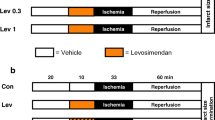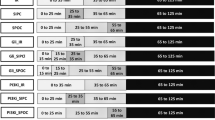Abstract
Post–conditioning (Post–C) induced cardioprotection involves activation of guanylyl–cyclase. In the ischemic preconditioning scenario, the downstream targets of cGMP include mitochondrial ATP–sensitive K+ (mKATP) channels and protein kinase C (PKC), which involve reactive oxygen species (ROS) production. This study tests the hypothesis that mKATP, PKC and ROS are also involved in the Post–C protection. Isolated rat hearts underwent 30 min global ischemia (I) and 120 min reperfusion (R) with or without Post–C (i.e., 5 cycles of 10 s R/I immediately after the 30 min ischemia). In 6 groups (3 with and 3 without Post–C) either mKATP channel blocker, 5– hydroxydecanoate (5–HD), or PKC inhibitor, chelerythrine (CHE) or ROS scavenger, N–acetyl–cysteine (NAC), were given during the entire reperfusion (120 min). In other 6 groups (3 with and 3 without Post–C), 5–HD, CHE or NAC were infused for 117 min only starting after 3 min of reperfusion not to interfere with the early effects of Post–C and/or reperfusion. In an additional group NAC was given during Post–C maneuvers (i.e., 3 min only). Myocardial damage was evaluated using nitro–blue tetrazolium staining and lactate dehydrogenase (LDH) release. Post–C attenuated myocardial infarct size (21 ± 3% vs. 64 ± 5% in control; p < 0.01). Such an effect was abolished by 5–HD or CHE given during either the 120 or 117 min of reperfusion as well as by NAC given during the 120 min or the initial 3 min of reperfusion. However, delayed NAC (i.e., 117 min infusion) did not alter the protective effect of Post– C (infarct size 32 ± 5%; p < 0.01 vs. control, NS vs. Post–C). CHE, 5–HD or NAC given in the absence of Post–C did not alter the effects of I/R. Similar results were obtained in terms of LDH release. Our data show that Post–C induced protection involves an early redox–sensitive mechanism as well as a persistent activation of mKATP and PKC, suggesting that the mKATP/ROS/PKC pathway is involved in post–conditioning.
Similar content being viewed by others
References
Angelos MG, Kutala VK, Torres CA, He G, Stoner JD, Mohammad M, Kuppusamy P (2005) Hypoxic Reperfusion of the Ischemic Heart and Oxygen Radical Generation. Am J Physiol Heart Circ Physiol In Press DOI:10. 1152/ajpheart. 00223. 2005
Atmaca G (2004) Antioxidant effects of sulfur–containing amino acids. Yonsei Med J 45:776–488
Becker LB (2004) New concepts in reactive oxygen species and cardiovascular reperfusion physiology. Cardiovasc Res 61:461–470
Bolli R, Patel BS, Jeroudi MO, Lai EK, McCay PB (1988) Demonstration of free radical generation in “stunned” myocardium of intact dogs with the use of the spin trap a–phenyl–N–tertbutyl nitrone. J Clin Invest 82:476–485
Cao Z, Liu L, Van Winkle DM (2005) Met5–enkephalin–induced cardioprotection occurs via transactivation of EGFR and activation of PI3K. (2005) Am J Physiol Heart Circ Physiol 288:H1955–H1964
Carroll R, Gant VA, Yellon DM (2001) Mitochondrial KATP channels protects a human atrial–derived cell line by a mechanism involving free radical generation. Cardiovasc Res 51:691–700
Chen W, Gabel S, Steenbergen C, Murphy E (1995) A redox–based mechanism for cardioprotection induced by ischemic preconditioning in perfused rat heart. Circ Res 77:424–429
Darling CE, Jiang R, Maynard M, Whittaker P, Vinten–Johansen J, Przyklenk K (2005) ‘Postconditioning’ via Stuttering Reperfusion Limits Myocardial Infarct Size in Rabbit Hearts: Role of ERK 1/2. Am J Physiol Heart Circ Physiol 289:H1618–H1626
Forbes RA, Steenbergen C, Murphy E (2001) Diazoxide–induced cardioprotection requires signaling through a redox–sensitive mechanism. Circ Res 88:802–809
Forman MB, Puett DW, Cates CU, McCroskey DE, Beckman JK, Greene HL, et al. (1988) Glutathione redox pathway and reperfusion injury. Effect of N–acetylcysteine on infarct size and ventricular function. Circulation 78:202–213
Gelpi RJ, Morales C, Cohen MV, Downey JM (2002) Xanthine oxidase contributes to preconditioning’s preservation of left ventricular developed pressure in isolated rat heart: developed pressure may not be an appropriate end–point for studies of preconditioning. Basic Res Cardiol 97:40–46
Halkos ME, Kerendi F, Corvera JS, Wang NP, Kin H, Payne CS, Sun HY, Guyton RA, Vinten–Johansen J, Zhao ZQ (2004) Myocardial protection with postconditioning is not enhanced by ischemic preconditioning. Ann Thorac Surg 78:961–969
Hanley PJ, Drose S, Brandt U, Lareau RA, Banerjee AL, Srivastava DK, Banaszak LJ, Barycki JJ, Van Veldhoven PP, Daut J (2005) 5–Hydroxydecanoate is metabolised in mitochondria and creates a ratelimiting bottleneck for beta–oxidation of fatty acids. J Physiol 562:307–318
Hausenloy DJ, Tsang A, Yellon DM (2005) The reperfusion injury salvage kinase pathway: a common target for both ischemic preconditioning and postconditioning. Trends Cardiovasc Med 15:69–75
Heusch G. Postconditioning: old wine in a new bottle? (2004) J Am Coll Cardiol 44:1111–1112
Lochner A, Genade S, Moolman JA (2003) Ischemic preconditioning: infarct size is a more reliable endpoint than functional recovery. Basic Res Cardiol 98:337–346
Kerendi F, Kin H, Halkos ME, Jiang R, Zatta AJ, Zhao ZQ, Guyton RA, Vinten– Johansen J (2005) Remote postconditioning Brief renal ischemia and reperfusion applied before coronary artery reperfusion reduces myocardial infarct size via endogenous activation of adenosine receptors. Basic Res Cardiol 100:404–412
Kin H, Zatta AJ, Lofye MT, Amerson BS, Halkos ME, Kerendi F et al. (2005) Postconditioning reduces infarct size via adenosine receptor activation by endogenous adenosine. Cardiovasc Res 67:124–133
Kin H, Zhao ZQ, Sun HY, Wang NP, Corvera JS, Halkos ME et al. (2004) Postconditioning attenuates myocardial ischemia–reperfusion injury by inhibiting events in the early minutes of reperfusion. Cardiovasc Res 62:74–85
Kloner RA, Jennings RB (2001) Consequences of brief ischemia: stunning, preconditioning and their clinical implications. Circulation 104:2981–2989
Krenz M, Oldenburg O, Wimpee H, Cohen MV, Garlid KD, Critz SD, Downey JM, Benoit JN (2002) Opening of ATPsensitive potassium channels causes generation of free radicals in vascular smooth muscle cells. Basic Res Cardiol 97:365–373
Krieg T, Cohen MV, Downey JM (2003) Mitochondria and their role in preconditioning’s trigger phase. Basic Res Cardiol 98:228–234
Krieg T, Qin Q, Philipp S, Alexeyev MF, Cohen MV, Downey JM (2004) Acetylcholine and bradykinin trigger preconditioning in the heart through a pathway that includes Akt and NOS. Am J Physiol Heart Circ Physiol 287:H2606–H2611
Ma XL, Gao F, Liu GL, Lopez BL, Christopher TA, Fukuto JM et al. (1999) Opposite effects of nitric oxide and nitroxyl on postischemic myocardial injury. Proc Natl Acad Sci USA 96:14617–14622
Okawa H, Horimoto H, Mieno S, Nomura Y, Yoshida M, Shinjiro S (2003) Preischemic infusion of alpha–human atrial natriuretic peptide elicits myoprotective effects against ischemia reperfusion in isolated rat hearts. Mol Cell Biochem 248:171–177
Pabla R, Buda AJ, Flynn DM, Blesse SA, Shin AM, Curtis MJ et al. (1996) Nitric oxide attenuates neutrophil–mediated myocardial contractile dysfunction after ischemia and reperfusion. Circ Res 78:65–72
Pagliaro P, Mancardi D, Rastaldo R, Penna C, Gattullo D, Miranda KM et al. (2003) Nitroxyl affords thiol–sensitive myocardial protective effects akin to early preconditioning Free Radic Biol Med 34:33–43
Pain T, Yang XM, Critz SD, Yue Y, Nakano A, Liu GS et al. (2000) Opening of mitochondrial KATP channels triggers the preconditioned state by generating free radicals. Circ Res 87:460–466
Patel HH, Gross GJ (2001) Diazoxide induced cardiprotecion: what comes first, KATP channels or reactive oxygen species? Cardiovasc Res 51:633–636
Penna C, Alloatti G, Cappello S, Gattullo D, Berta G, Mognetti B et. al. (2005a) Platelet–activating factor induces cardioprotection in isolated rat heart akin to ischemic preconditioning: role of phosphoinositide 3–kinase and protein kinase C activation. Am J Physiol Heart Circ Physiol 288:H2512–H2520
Penna C, Cappello S, Mancardi D, Raimondo S, Rastaldo R, Gattullo D et al. (2005b) Post–Conditioning Reduces Infarct Size in the Isolated Rat Heart: Role of Coronary Flow and Pressure and the Nitric Oxide/cGMP Pathway. Basic Res Cardiol In Press [DOI: 10. 1007/s00395– 005–0543–6]
Przyklenk K, Kloner RA (1989) “Reperfusion injury” by oxygen–derived free radicals? Effect of superoxide dismutase plus catalase, given at the time of reperfusion, on myocardial infarct size, contractile function, coronary microvasculature, and regional myocardial blood flow. Circ Res 64:86–96
Sasaki N, Sato T, Ohler A, O’Rourke B, Marban E (2000) Activation of mitochondrial ATP–dependent potassium channels by nitric oxide. Circulation 101:439–445
Sato H, Jordan JE, Zhao ZQ, Sarvotham SS, Vinten–Johansen J (1997) Gradual reperfusion reduces infarct size and endothelial injury but augments neutrophil accumulation. Ann Thorac Surg 64:1099–1107
Sato T, Marban E (2000) The role of mitochondrial K(ATP) channels in cardioprotection. Basic Res Cardiol 95:285–289
Serviddio G, Di Venosa N, Federici A, D’Agostino D, Rollo T, Prigigallo F, Altomare E, Fiore T, Vendemiale G (2005) Brief hypoxia before normoxic reperfusion (postconditioning) protects the heart against ischemia–reperfusion injury by preventing mitochondria peroxide production and glutathione depletion. FASEB J 19:354–361
Staat P, Rioufol G, Piot C, Cottin Y, Cung TT, L’Huillier I, Aupetit JF, Bonnefoy E, Finet G, Andre–Fouet X, Ovize M (2005) Postconditioning the human heart. Circulation 112:2143–2148
Sun HY, Wang NP, Kerendi F, Halkos M, Kin H, Guyton RA et al. (2005) Hypoxic postconditioning reduces cardiomyocyte loss by inhibiting ROS generation and intracellular Ca2+ overload. Am J Physiol Heart Circ Physiol 288:H1900–H1908
Tsang A, Hausenloy DJ, Mocanu MM, Yellon DM (2004) Postconditioning: a form of “modified reperfusion” protects the myocardium by activating the phosphatidylinositol 3–kinase–Akt pathway. Circ Res 95:230–232
Tsang A, Hausenloy DJ, Yellon DM (2005) Myocardial postconditioning: reperfusion injury revisited. Am J Physiol Heart Circ Physiol 289:H2–H7
Valen G, Vaage J (2005) Pre– and postconditioning during cardiac surgery. Basic Res Cardiol 100:179–186
Vinten–Johansen J, Zhao ZQ, Zatta AJ, Kin H, Halkos ME, Kerendi F (2005) Postconditioning A new link in nature’s armor against myocardial ischemiareperfusion injury. Basic Res Cardiol 100:295–310
Wang Y, Takashi E, Xu M, Ayub A, Ashraf M (2001) Downregulation of protein kinase C inhibits activation of mitochondrial K(ATP) channels by diazoxide. Circulation 104:85–90
Yang XM, Philipp S, Downey JM, Cohen MV (2005) Postconditioning’s protection is not dependent on circulating blood factors or cells but involves adenosine receptors and requires PI3–kinase and guanylyl cyclase activation. Basic Res Cardiol 100:57–63
Yang XM, Proctor JB, Cui L, Krieg T, Downey JM, Cohen MV (2004) Multiple, brief coronary occlusions during early reperfusion protect rabbit hearts by targeting cell signaling pathways. J Am Coll Cardiol 44:1103–1110
Zhao ZQ, Corvera JS, Halkos ME, Kerendi F, Wang NP, Guyton RA et al. (2003) Inhibition of myocardial injury by ischemic postconditioning during reperfusion: comparison with ischemic preconditioning. Am J Physiol Heart Circ Physiol 285:H579–588
Author information
Authors and Affiliations
Corresponding author
Rights and permissions
About this article
Cite this article
Penna, C., Rastaldo, R., Mancardi, D. et al. Post–conditioning induced cardioprotection requires signaling through a redox–sensitive mechanism, mitochondrial ATP–sensitive K+ channel and protein kinase C activation. Basic Res Cardiol 101, 180–189 (2006). https://doi.org/10.1007/s00395-006-0584-5
Received:
Revised:
Accepted:
Published:
Issue Date:
DOI: https://doi.org/10.1007/s00395-006-0584-5




